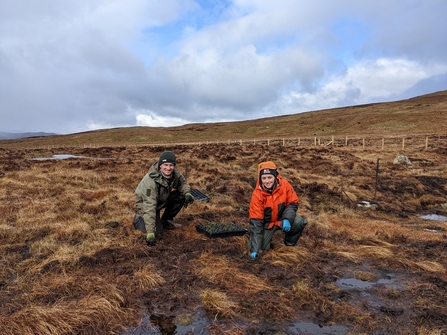
Around 26,000 plug plants have been planted at Armboth Fell as part of a peatland restoration programme © Cumbria Wildlife Trust

Around 26,000 plug plants have been planted at Armboth Fell as part of a peatland restoration programme © Cumbria Wildlife Trust
It’s crucial that we repair damaged peatland, so that it can return to a more natural state of capturing and storing CO2 and holding back water.Sean ProkopiwPeatland Restoration Officer, Cumbria Wildlife Trust
A team of four people from Terra Firma Environmental Ltd have spent a week planting shrubs and cottongrasses by hand on peatland at Armboth Fell near Thirlmere. This marked the end of the latest phase of a major peatland restoration project that we working on in partnership with the National Trust, United Utilities, Natural England and Fix the Fells. We are restoring important peat habitat on Armboth Fell, which has been damaged by years of recreational and grazing pressures.
Around 26,000 plants were all planted by hand, including cottongrass (also known as bog cotton) and dwarf shrubs such as common heather, bilberry and crowberry. The aim is to give the dried-out areas of peatland the best chance of recovery. By covering them with vegetation, the roots will stabilise the damaged peat and allow them to retain more water.
Sean Prokopiw, Peatland Restoration Officer for Cumbria Wildlife Trust said: “Healthy peatlands are a fantastic store of CO2 and have amazing water-holding capacity. The problem with damaged peatland is that it releases CO2 into the atmosphere and loses its ability to store water effectively. That’s why it’s crucial that we repair it, so that it can return to a more natural state of capturing and storing CO2 and holding back water. Armboth Fell is a sensitive, protected area with upland breeding birds present, so we couldn’t use machinery to plant these thousands of plug plants – they were all planted by hand! They’re covering bare areas of peat which were previously open to the elements, which dried them out further. Having this vegetation on top will stabilise the dried peat, ensuring that the carbon trapped within is secure, and not released back into the environment.”
Joe Cornforth, Lead Ranger for National Trust said: “This is a great example of what can be achieved when working in partnership. Cumbria Wildlife Trust has done an amazing job delivering the work on Armboth. The new pools create the ideal wet environment for plants that thrive in peat bogs, such as Sphagnum moss, the main component of peat. As well as keeping the peat saturated to stop the release of C02, it also provides vital habitats and improves the water quality on the site and reduces the risk of flooding in the valleys either side.”
Prior to the plug planting, heavy machinery had been on site to stabilise eroding areas of peat and to create features to rewet and restore important bog vegetation. The next stage will cover similar work in other areas, to restore as much degraded peatland as possible around Armboth Fell.
Armboth Fell is an important area for breeding birds, in particular upland species such as peregrine falcon, buzzard, raven, ring ouzel, stonechat, wheatear and red grouse. The work had to be carried out in early April, just prior to the breeding season, so that ground nesting birds, such as skylark and meadow pipit, were not disturbed.
The shrubs planted at Armboth Fell - common heather, bilberry and crowberry – all do well in drier conditions, so they are likely to be most successful at covering this area of dried peatland. Having this good mix of shrubs creates a more diverse habitat, which supports a range of important species, including northern eggar and emperor moths, merlin and peregrine falcon.
The Derwent Riverlands project is part funded by the European Agricultural Fund for Rural Development.

To give the dried-out areas of peatland the best chance of recovery, they are covered with vegetation, including cottongrass. The roots stabilise the damaged peat and allow them to retain more water © Cumbria Wildlife Trust